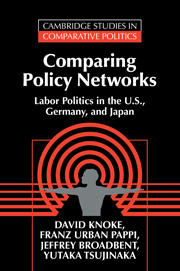Book contents
- Frontmatter
- Contents
- List of tables and figures
- Preface
- Acknowledgements
- 1 Policy-making in the Organizational State
- 2 Three Labor Policy Domains
- 3 Finding Domain Actors
- 4 Organizational Policy Interests
- 5 Policy Webs: Networks, Reputations, and Activities
- 6 Fighting Collectively: Action Sets and Events
- 7 Exchange Processes
- 8 Power Structures
- 9 Variations on a Theme of Organizational States
- Appendix 1 Legislative Procedures in Three Nations
- Appendix 2 Labor Policy Domain Organizations by Type
- Appendix 3 Cluster Analyses of Labor Policy Domain Issues
- Appendix 4 Labor Policy Domain Legislative Bills
- References
- Index
8 - Power Structures
Published online by Cambridge University Press: 05 June 2012
- Frontmatter
- Contents
- List of tables and figures
- Preface
- Acknowledgements
- 1 Policy-making in the Organizational State
- 2 Three Labor Policy Domains
- 3 Finding Domain Actors
- 4 Organizational Policy Interests
- 5 Policy Webs: Networks, Reputations, and Activities
- 6 Fighting Collectively: Action Sets and Events
- 7 Exchange Processes
- 8 Power Structures
- 9 Variations on a Theme of Organizational States
- Appendix 1 Legislative Procedures in Three Nations
- Appendix 2 Labor Policy Domain Organizations by Type
- Appendix 3 Cluster Analyses of Labor Policy Domain Issues
- Appendix 4 Labor Policy Domain Legislative Bills
- References
- Index
Summary
This final empirical chapter weaves together the diverse strands of the preceding analyses into a comprehensive fabric: the power structures of the three national policy domains. Specifically, we combine three types of interorganizational relationships – the communication exchanges (Chapter 5), organizational reputations (Chapter 5), and action-set coalitions (Chapter 6) – to reveal the multiplex patterns connecting core and peripheral clusters of actors identified by equivalent ties to one another. These relationships among positions jointly define the structures through which power is generated and distributed among actors (Knoke, 1981: 275). Any power structure analysis must build on two types of theoretical premises: first, the conceptualizations of power from which the important dimensions of power relationships can be derived; and second, the theoretical perspectives that can be used to interpret the resulting structures. Concerning the first problem, we rely on a network concept of power and use blockmodel analysis to generate images of basic power structures. Regarding the second problem, the organizational state's contrast to pluralist and corporatist concepts of power relations guide our interpretations of the power structures.
Within national policy domains, organizations formulate, collectively decide, and implement binding policies. The people involved in public policy-making apply conventional definitions of domains, which often coincide with the jurisdictions of legislative committees or state ministries. Participants perceive that problems, issues, and solutions belong to a domain because of certain substantive similarities (Burstein, 1991), even if the political actors realize that they have some discretion in framing matters to fit into a variety of domains.
- Type
- Chapter
- Information
- Comparing Policy NetworksLabor Politics in the U.S., Germany, and Japan, pp. 189 - 208Publisher: Cambridge University PressPrint publication year: 1996

